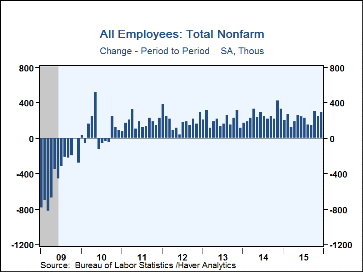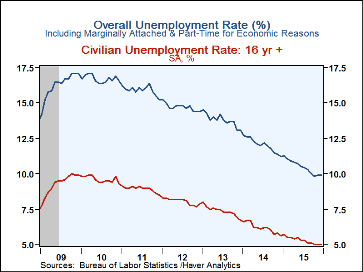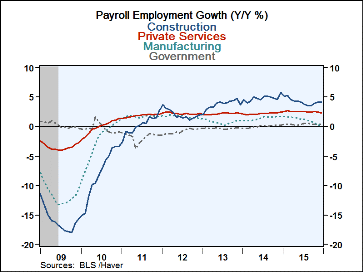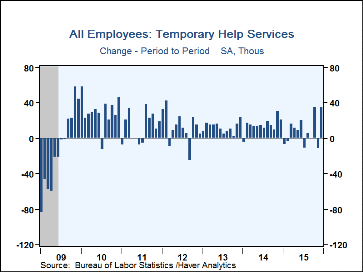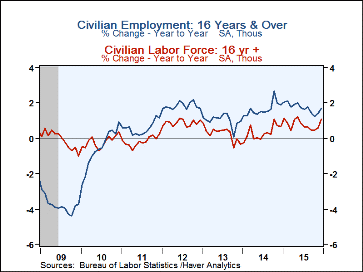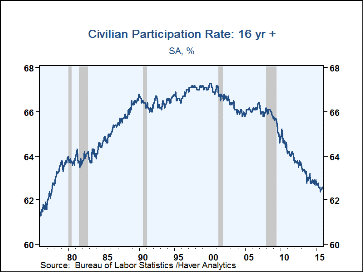 Global| Jan 08 2016
Global| Jan 08 2016U.S. Payrolls Show Surprising Strength; Jobless Rate And Earnings Remain Steady
by:Tom Moeller
|in:Economy in Brief
Summary
Nonfarm payrolls increased by a firm 292,000 during December following upwardly revised gains in the prior two months. Expectations had been for a 194,000 rise in the Action Economic Forecast Survey. The gain was powered by strength [...]
Nonfarm payrolls increased by a firm 292,000 during December following upwardly revised gains in the prior two months. Expectations had been for a 194,000 rise in the Action Economic Forecast Survey. The gain was powered by strength in service-producing industries. The unemployment rate remained unchanged as expected at 5.0%. The overall unemployment rate including marginally-attached workers and those employed part-time for economic reasons also was unchanged at 9.9%. A roughly unchanged level of average hourly earnings disappointed forecasts for a 0.2% rise.
From the payroll employment survey, December's 292,000 increase in employment followed increases of 252,000 and 307,000 in the prior two months, last month reported as 211,000 and 298,000. Still showing little employment strength was the factory sector where employment rose 8,000 (0.3% y/y) following lesser or negative readings in the prior four months. Mining sector employment declined 8,000, down 14.4% from the peak twelve months ago. Still showing strength, however, was the construction sector where jobs rose 45,000 (4.4%), near the monthly highs of the economic expansion.
Private service-sector payrolls improved 230,000 following increases of 201,000 and 278,000 in the prior two months. The gain reflected strength in most categories, led by a 73,000 rise (3.1% y/y) in professional & business services. Roughly half of that gain was due to a rise in temporary jobs (3.1% y/y). Health care & social assistance employment rose a firm 52,600 (3.2% y/y) while trade, transportation & utilities employment increased 31,000 (1.7% y/y). Lesser gains were logged by leisure & hospitality industries, up 29,000 (2.9% y/y), and transportation & warehousing employment which rose 23,100 (2.2% y/y). Finally, financial activities employment gained 11,000 (1.8% y/y) and retail trade employment rose 4,300 (1.7% y/y). In the government sector, the jobs market has strengthened. A 17,000 worker increase was the best performance in four months. It reflected a 7,000 improvement (0.3% y/y) in local government jobs, a 6,000 increase (0.7% y/y) in employment by states and a 4,000 rise (0.8% y/y) in the federal sector.
The breadth of employment broadened to 64.4% of industries last month, the widest in a year. It reflected 58.8% of factory sector industries adding employees, the most since January. During the last twelve months, however, a slightly reduced 69.8% of industries added workers. That compares to a peak of 81.7% as of February.
Strength in the employment figures did not translate into strength in hours and earnings. Employees worked a steady 34.5 hours in December, a figure reduced from the 34.6 hours during the first and third quarters. Factory sector hours eased to 40.6 but the construction sector jumped to 37.7 hours. The service sector held at the recovery high of 34.4 hours. The index of aggregate hours worked (employment times hours) increased 2.1% (AR) versus Q3, slightly reduced from 2.7% in Q3.
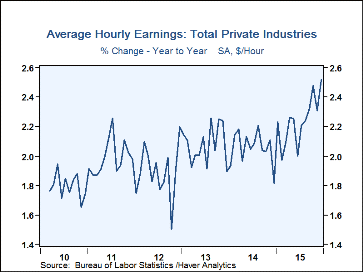 Average hourly earnings eased slightly m/m for the first time
in twelve months. The y/y gain improved, however, to 2.5%, its best rise of the
cycle as it compared to a monthly decline twelve months ago. Construction sector
earnings rose 2.9% y/y, factory sector earnings rose 2.5% y/y and private
service pay also increased 2.5% y/y. Each of the readings were stronger than
1.9% in the mining sector, where earnings fell in two of the last three months.
Average hourly earnings eased slightly m/m for the first time
in twelve months. The y/y gain improved, however, to 2.5%, its best rise of the
cycle as it compared to a monthly decline twelve months ago. Construction sector
earnings rose 2.9% y/y, factory sector earnings rose 2.5% y/y and private
service pay also increased 2.5% y/y. Each of the readings were stronger than
1.9% in the mining sector, where earnings fell in two of the last three months.
The household employment report indicated that the stable 5.0% unemployment rate reflected a 485,000 rise (1.7% y/y) in employment, the most since January, and a 466,000 increase (1.1% y/y) in the labor force. The unemployment rate was half the recession peak in October 2009. The decline was helped by a lower labor force participation rate which, at 62.6% was down from 66.2% in 2006. Growth in workers not in the labor force ranged between 1.8% and 2.7% since 2009.
The duration of unemployment fell to an average 27.6 weeks, down from a 2011 monthly peak of 40.7 weeks. The percentage of those unemployed 52 weeks or longer fell m/m to 17.8 weeks, down from a 2011 peak of 32.8 weeks.
The unemployment rate for individuals without a high school diploma fell to 6.7% while for high school graduates but no college it was 5.6%. For those with some college but no diploma, the jobless rate was 4.1%. For college graduates, it was 2.5%.
The labor market data is contained Haver's USECON database. Detailed figures are in the EMPL and LABOR databases. The expectations figure is in the AS1REPNA database.
Reducing Poverty via Minimum Wages, Alternatives from the Federal Reserve Bank of San Francisco can be found here.
| Employment: (SA, M/M Change, 000s) | Dec | Nov | Oct | Y/Y | 2015 | 2014 | 2013 |
|---|---|---|---|---|---|---|---|
| Payroll Employment | 292 | 252 | 307 | 1.9% | 2.1% | 1.9% | 1.7% |
| Previous | -- | 211 | 298 | -- | -- | -- | -- |
| Manufacturing | 8 | 2 | 3 | 0.3 | 1.1 | 1.4 | 0.8 |
| Construction | 45 | 48 | 35 | 4.4 | 4.3 | 4.8 | 3.7 |
| Private Service-Producing | 230 | 201 | 278 | 2.4 | 2.6 | 2.2 | 2.2 |
| Government | 17 | 12 | -5 | 0.4 | 0.5 | 0.0 | -0.3 |
| Average Weekly Hours - Private Sector | 34.5 | 34.5 | 34.6 | 34.6 (Dec.'14) |
34.5 | 34.5 | 34.5 |
| Private Sector Average Hourly Earnings (%) | -0.0 | 0.2 | 0.3 | 2.5 | 2.2 | 2.1 | 2.1 |
| Unemployment Rate (%) | 5.0 | 5.0 | 5.0 | 5.6 (Dec.'14) |
5.3 | 6.2 | 7.4 |
Tom Moeller
AuthorMore in Author Profile »Prior to joining Haver Analytics in 2000, Mr. Moeller worked as the Economist at Chancellor Capital Management from 1985 to 1999. There, he developed comprehensive economic forecasts and interpreted economic data for equity and fixed income portfolio managers. Also at Chancellor, Mr. Moeller worked as an equity analyst and was responsible for researching and rating companies in the economically sensitive automobile and housing industries for investment in Chancellor’s equity portfolio. Prior to joining Chancellor, Mr. Moeller was an Economist at Citibank from 1979 to 1984. He also analyzed pricing behavior in the metals industry for the Council on Wage and Price Stability in Washington, D.C. In 1999, Mr. Moeller received the award for most accurate forecast from the Forecasters' Club of New York. From 1990 to 1992 he was President of the New York Association for Business Economists. Mr. Moeller earned an M.B.A. in Finance from Fordham University, where he graduated in 1987. He holds a Bachelor of Arts in Economics from George Washington University.


